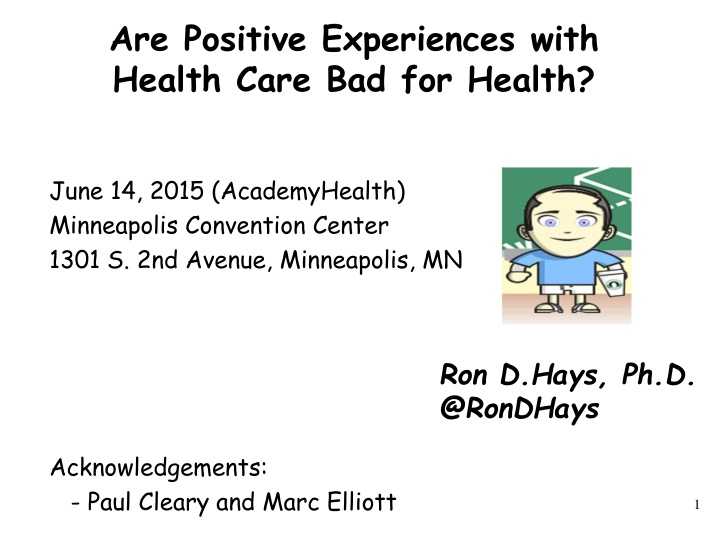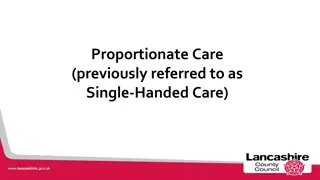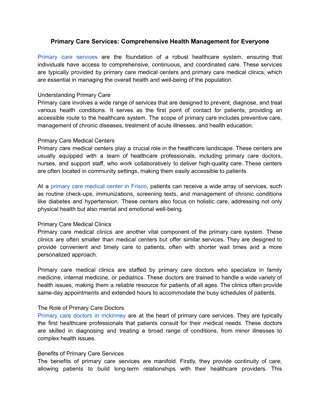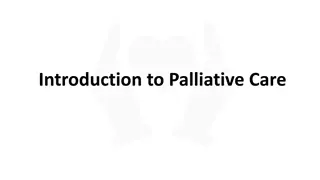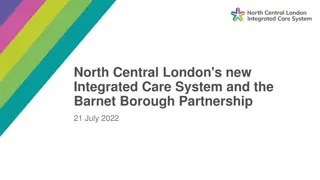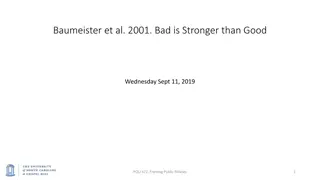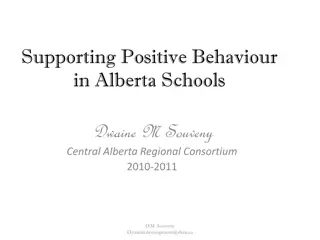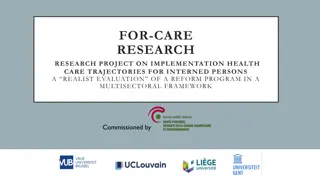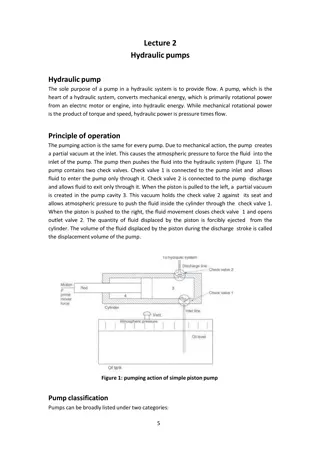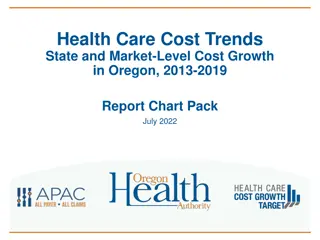Are Positive Experiences with Health Care Bad for Health?
Examine the potential negative effects of positive health care experiences on patient outcomes, including the influence of technical quality of care and patient satisfaction. Insights from studies and surveys reveal contrasting viewpoints on the benefits and risks associated with excellent health care encounters, shedding light on the complexity of patient care dynamics.
Download Presentation

Please find below an Image/Link to download the presentation.
The content on the website is provided AS IS for your information and personal use only. It may not be sold, licensed, or shared on other websites without obtaining consent from the author.If you encounter any issues during the download, it is possible that the publisher has removed the file from their server.
You are allowed to download the files provided on this website for personal or commercial use, subject to the condition that they are used lawfully. All files are the property of their respective owners.
The content on the website is provided AS IS for your information and personal use only. It may not be sold, licensed, or shared on other websites without obtaining consent from the author.
E N D
Presentation Transcript
Are Positive Experiences with Health Care Bad for Health? June 14, 2015 (AcademyHealth) Minneapolis Convention Center 1301 S. 2nd Avenue, Minneapolis, MN Ron D.Hays, Ph.D. @RonDHays Acknowledgements: - Paul Cleary and Marc Elliott 1
Is Receiving Better Technical Quality of Care Bad for Health? Change in SF-12 PCS regressed on process of care aggregate Process of care PCS Hypothesized positive effect, but regression coefficient was NOT SIGNIFICANT unstandardized beta = -1.41, p =.188 Kahn et al. (2007), Health Services Research, Article of Year
Use of and Importance of Patient Experience Surveys has Grown CAHPS Hospital Survey (HCAHPS) data accounted for 30% of hospitals Total Performance Score in Value-Based Purchasing Program in FY2014 so has misinformation about them 3
Some Suggest that Consumers Lack Expertise Needed to Evaluate Care Quality Patients are the only source of some process of care measures (e.g., were things explained in a way you could understand?) Patients are the best source of information on communication, office staff courtesy and respect, access to care, and other issues covered by CAHPS surveys CAHPS reports of care are reliable and valid. 4 CAHPS complements technical quality measures
Some suggest patients can be satisfied to death. Fenton et al. 2012 JAMA Internal Medicine Medical Expenditure Panel Survey 4 items from CAHPS communication composite 0-10 global rating of health care More positive assessment of care associated with higher mortality Results interpreted by some as indicating that acceding to patient demands results in expensive and dangerous treatment. 5
Five Concerns with Fenton et al. 1. Associations may be due to unmeasured variables (e.g., severity of illness). 2. Estimated effect was implausibly large, suggesting good patient experience is more dangerous than having major chronic conditions. 3. Only amenable deaths can be prevented by health care. 4. Patient experiences with care vary over time. Used CAHPS data at MEPS round 2 to predict mortality 3 months to 6 years later. > half of deaths occurred more than 2 years after this. Among those with best (quartile 4) experiences at baseline, > half had worse experiences 1 year later 5. Only looked at 5-item aggregate of CAHPS items. 7
Reanalysis of Fenton et al. by Xu et al. (2014) Same data used by Fenton et al. 2000-2005 Medical Expenditure Panel Survey data National Health Interview Survey National Death Index Same statistical analysis Cox proportional hazards models with mortality as the dependent variable and patient experience measures as independent variables But, unlike Fenton et al. Separated non-amenable and amenable deaths Considered timing of patient experience and death Looked at individual items to better understand the patient experience with mortality association 8
Patient Experiences and Mortality: Non-Amenable vs. Amenable Deaths Non-Amenable Mortality Hazard Ratio (1.00) 1.07 0.96 1.26 Amenable Mortality Hazard Ratio (1.00) 1.27 1.28 1.23 Patient Care Experience p-value p-value Quartile 1 (reference) Quartile 2 Quartile 3 Quartile 4 (most positive) 0.56 0.70 0.03 0.25 0.25 0.32 Overall p-value for patient care experience quartiles 0.03 0.59 9
Patient Experiences and Mortality: Consistency of Experiences Over Time Patient Care Experience (baseline : 1 year later) All-Cause Mortality Hazard Ratio p-value Quartile 1 : Quartile 1 (reference) Quartile 2 : Quartile 2 Quartile 3 : Quartile 3 Quartile 4 : Quartile 4 Different quartiles at baseline and 1 year later (1.00) 0.89 1.13 1.09 0.42 0.57 0.54 0.88 0.35 10
Patient Experiences and Mortality: Significant for Only One Measure Patient Care Experience Items All-Cause Mortality Hazard Ratio 1.10 p-value 0.15 Rating of healthcare 9-10 vs 0-8 Listen carefully to you Show respect for what you had to say Explain things in a way that is easy to understand Spend enough time with you 0.98 1.05 0.76 0.44 1.09 0.17 1.17 0.03 Always" versus Never / Sometimes / Usually 11
Concluding Statements Rather than patient demands producing expensive and dangerous treatment, the data are consistent with other studies that indicate more intensive care at the end-of-of life in the U.S. (Elliott et al., 2013, JAGS). Patient experience surveys assess important dimensions of care for which patients are the best or only source of information Improving patient experience does not lead to inappropriate and inefficient care or result in trade-offs with high-quality clinical care 12
Relevant Readings Price, R. A. Elliott, M.N., et al. (2015). Should health care providers be accountable for patients care experiences? JGIM, 30, 253-256. Price, R. A., Elliott, M. N., et al. (2014). Examining the role of patient experience surveys in measuring health care quality. Medical Care Research and Review, 71, 522-554. Xu, X., Buta, E. et al. (2014 epub). Methodological considerations when studying the association between patient-reported care experiences and mortality. Health Services Res.
Thank you. drhays@g.ucla.edu @RonDHays (twitter) Powerpoint file at: http://gim.med.ucla.edu/FacultyPages/Hays/ 14
